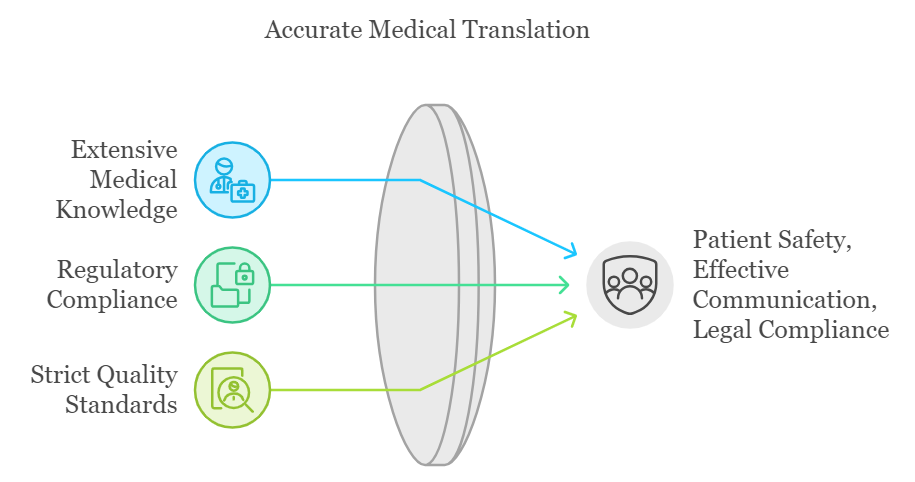How to Ensure Accuracy in
Medical Document Translation
11
Imagine you’re sitting with your doctor, discussing your treatment plan. The doctor needs to share your medical records with a specialist who speaks a different language. Ensuring those records are accurately translated is crucial for your health and safety. Let’s dive into the world of medical document translation and uncover some tips and best practices to maintain accuracy.
The Vital Role of Certified Translation Services
Certified translation services are the backbone of accurate communication in the medical and legal sectors. Whether it’s a complex medical report or a legal document, these services ensure that every word is translated with precision and confidentiality. Certified offices in locations like South Riyadh and Jeddah are well-regarded for their high standards, adhering to recognized benchmarks like ISO 9001:2015.
What Makes Certified Translation Services Stand Out?
- Legal Recognition: Translations are legally recognized and can be used in courts and government institutions.
- Confidentiality: Ensuring the confidentiality of sensitive information is paramount.
- Native-Speaking Translators: Employing native-speaking translators for accurate and culturally sensitive translations.
- Efficiency: Delivering translations quickly without compromising on quality.
The Critical Need for Accuracy in Medical Translation
Medical translation isn’t just about converting words from one language to another. It’s about ensuring patient safety, effective communication, and legal compliance. Inaccurate translations can lead to misdiagnoses, incorrect treatments, and significant legal issues.
Key Elements of Accurate Medical Translation
- Extensive Medical Knowledge: Certified medical translators have a deep understanding of medical terminology.
- Regulatory Compliance: Adhering to regulations like HIPAA in the U.S. to protect patient information.
- Strict Quality Standards: Following rigorous quality assurance processes to ensure precision.

Leveraging Translation Technologies and Processes
In today’s digital age, technology plays a significant role in maintaining the accuracy and security of medical translations. Secure communication channels and storage solutions are essential for protecting sensitive data.
Enhancing Accuracy with Technology
- Computer-Assisted Translation (CAT) Tools: These tools help translators maintain consistency and accuracy.
- Translation Memory Systems: Storing previously translated texts to improve efficiency and coherence.
- Quality Assurance Processes: Including peer reviews, proofreading, and validation by medical professionals.
The Importance of Cultural Sensitivity and Legal Compliance
Translators must not only be proficient in both the source and target languages but also be culturally sensitive. Understanding medical terminology and legal standards in different cultures ensures effective communication and compliance with regulations.
Tips for Culturally Sensitive Translations
- Understanding Cultural Nuances: Being aware of cultural differences that may affect the interpretation of medical terms.
- Continuous Monitoring: Keeping up with evolving standards and practices to stay compliant.
Overcoming Challenges in Medical Translation
Medical translation comes with its own set of challenges. From complex terminology to the need for speed and accuracy, translators face numerous hurdles. However, following best practices can help overcome these challenges.
Best Practices for Accurate Medical Translation
- Employing Subject-Matter Experts: Using translators who specialize in medical terminology.
- Specialized Translation Tools: Leveraging tools designed for medical translations.
- Rigorous Quality Assurance: Implementing thorough proofreading and validation processes.
- Ensuring Confidentiality: Using end-to-end encryption and non-disclosure agreements to protect sensitive information.
Service Providers and Their Market Position
Companies like Rapid Translate and ALTA Language Services are renowned for their commitment to quality and accuracy. They employ certified translators and offer a range of services across multiple languages, catering to various sectors including healthcare, legal, business, and manufacturing.
Additional Services Offered
- Proofreading: Ensuring the final document is free of errors.
- 3D Printing: Providing innovative solutions for medical models.
- Bookbinding and Administrative Consulting: Offering comprehensive support services.
Latest Words
Certified translation services are indispensable in our globalized world, especially in the medical and legal fields. They ensure accuracy, maintain confidentiality, and adhere to regulatory standards, facilitating effective communication and enhancing patient care and legal compliance. By leveraging advanced technologies and following best practices, these services deliver high-quality translations that meet the highest standards.
A Quiz for Our Readers
To make sure you’ve grasped the key points, here’s a little quiz for you:
- Why is accuracy crucial in medical document translation?
- What are some key elements of accurate medical translation?
- Name two technologies that enhance translation accuracy.
- Why is cultural sensitivity important in medical translation?
- What are some best practices for overcoming challenges in medical translation?
Share your answers in the comments below!
